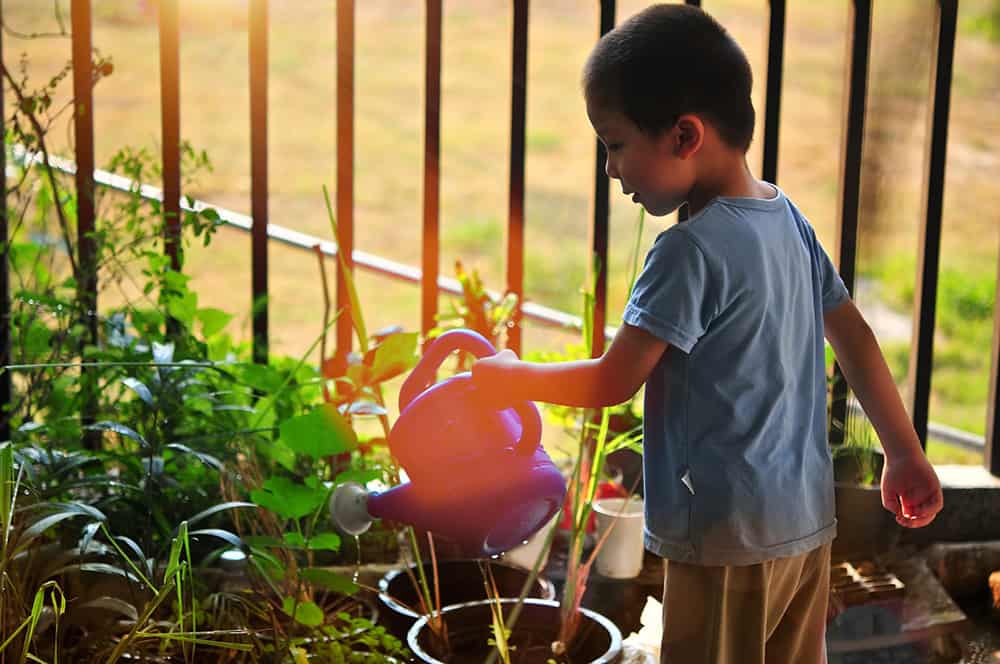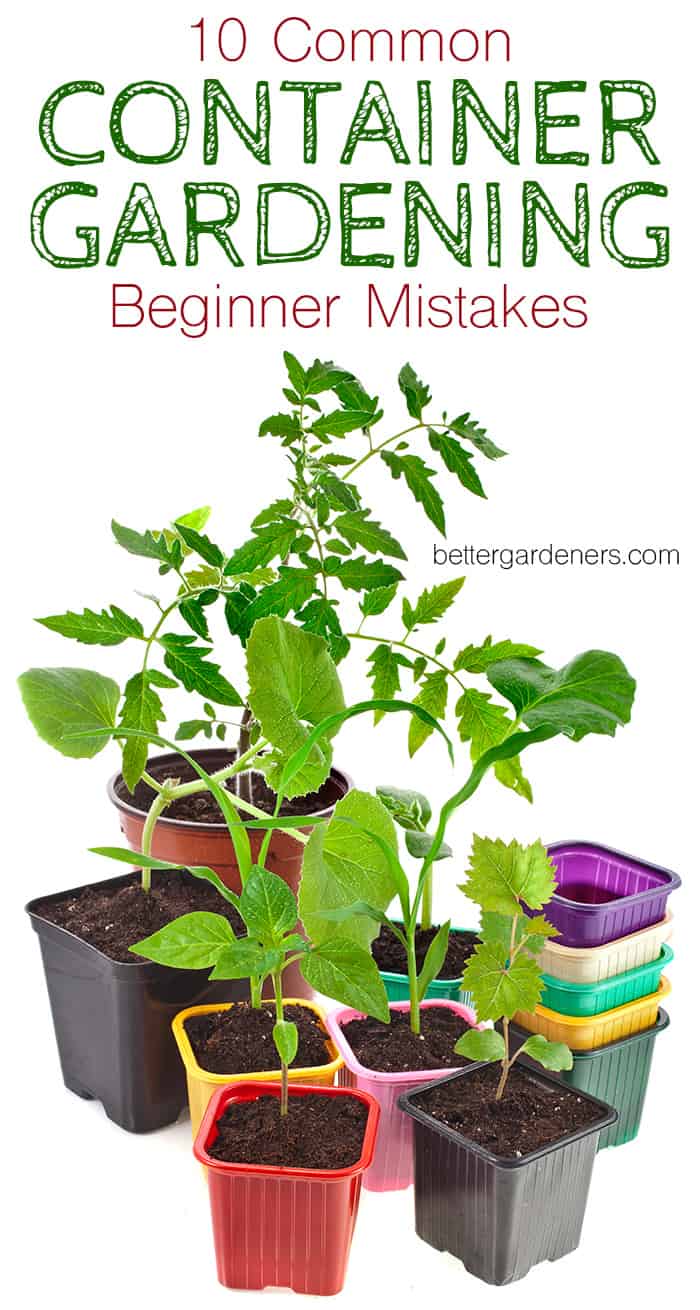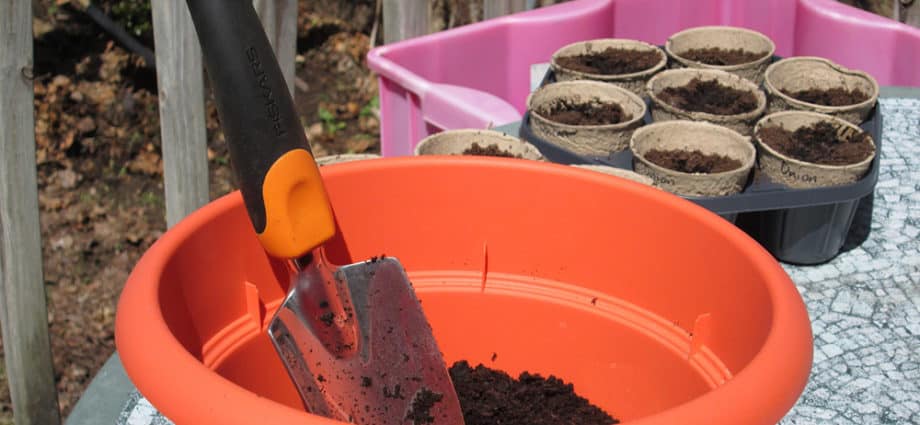One of my favorite things to do in the spring and early summer is walk around my neighborhood and see what people are planting and growing. Since I live in the city, my neighborhood is filled with apartment buildings with plenty of balconies and porches, but not really any yards. Because of this, most of the plants I see are in container gardens. Over the years, as I’ve gotten more experience growing fruits, vegetables, and herbs in containers on my own patio, I’ve noticed patterns of common mistakes made by newbies. For this article, I’m rounding up all of these common container gardening mistakes so you can avoid them when you start your own patio garden.
Common Container Gardening Mistakes
1. Using Small Containers
This is hands down the most common mistake I see. Everyone loves a juicy, fresh tomato from the garden and while many varieties are very easy to grow in containers, the plants are doomed to failure if they’re in a pot that’s just too small.
The mistake can be made with almost any vegetable: you see a cute pot at Target or your local gardening store and buy it without any concern about the size. While it may seem like your seedling is thriving during the early days of the growing season, eventually, your plant will outgrow its pot.
Sadly, the most common sign that a container is too small is a lack of “fruit” from your plant. If your tomato, squash, or cucumber plant is barely producing or not producing at all, you should double check to make sure you’ve provided a pot big enough for your veggie.

2. Picking the Wrong Type of Container
In addition to size, you should pay attention to what a container is made of. For edible container gardens, you should avoid any containers that contain lead or other toxic materials that can leach into the soil and your food. This is frequently a problem when old or vintage household items are repurposed as growing containers.
Some gardeners gravitate toward traditional orange clay terra cotta pots, but because of the porousness of the material, they can dry out much more quickly than plants in plastic containers, leaving your plants underwatered. Black pots and metal pots should be avoided because they retain the heat of the sun and can cook the roots of your plants. If you avoid these types of containers, your plants will be happier.
3. Planting Too Densely
Often when gardeners have larger containers or use elevated garden beds with plenty of space, they make the mistake of overcrowding the container. While planting small seedlings, many beginners forget to take into account how large their plant will become later in the summer.
A crowded planter can lead to stunted growth and easily spread diseases while creating a haven for pests. Plus, if you’re growing fruits and veggies, your harvest will not yield a good bounty. Make sure to read spacing instructions on your seed packets or the tags that come with seedlings at garden stores.
If you’re more of a planner, square-foot gardening is a great technique to use, especially for raised garden beds, to make sure you’re giving each of your vegetables and herbs the space they need to thrive.
4. Planting the Wrong Types of Vegetables
While there are many veggies and herbs that you can just plop in a planter and they’ll grow well, some varieties need the space and freedom of a traditional garden bed to really thrive.
With a big enough container, you can grow anything, but if you’re like most container gardeners, you probably have limited space to work with. Look for varieties of vegetables that are compact (many of them have “bush” or “patio” in the name). They’re designed to take up less space and thrive in containers. Common examples include Patio Princess Tomatoes, Bush Champion Cucumber, and Patio Baby Eggplant.
5. Not Watering Enough
Plants in containers dry out much faster than their counterparts in the ground. The smaller volume of soil means there isn’t a lot of space to store moisture. This becomes a big problem when summer weather turns hot and dry. If you aren’t paying attention to your vegetable container garden, your plants can wilt or even die. Usually a thorough watering once or twice a day will be enough to keep your plants from getting thirsty. Alternatively, you can use a drip water irrigation system or self-watering containers to continually water your veggies for you.
A good rule to remember: if the top inch of soil in your pot is dry, it’s time to water. Make sure you’re watering the soil and not the leaves of your plants.

6. Watering Too Much
Enthusiastic watering can be a problem, but more often overwatering is caused when your container garden doesn’t have enough drainage. Any container you use should have drainage holes in the bottom. If you’re using a DIY container or bucket, make sure to drill holes in the bottom for excess water to escape.
Another thing to consider is the type of soil you’re using. Don’t just dig up dirt from your yard and put it in the pot. Buy or make your own potting soil, which is less dense than garden soil and allows the water to move downward drain out of your pot.
7. Not Enough (or Too Much) Light
If you’re a city dweller or live in an apartment building, you probably have limited location options for your container garden. If your balcony, patio, or other outdoor space is shady most the day or gets full light from sunrise to sunset, that’s going to dictate what plants you can grow.
While you can add shade to a sunny spot, it’s basically impossible to create more sunlight. Try as we might, the 3-4 hours of sunlight we get on our patio in the afternoon and evening has never been enough to successfully grow zucchinis.
Make sure you observe the space you plan to put your container garden in and note how much sunlight it receives on a sunny day. The plants you select should match that. Tomatoes, squash, and cucumbers will enjoy a sunny roof garden, while lettuces and other greens, plus many herbs would prefer a shady patio. Match your plants to your space and you’ll see a lot of success in your container garden.
8. Skipping the Fertilizer
When planted in a container, the veggies and herbs are limited to the nutrients of their potting soil. It’s not surprising that those nutrients can be used up really fast–especially if you’re reusing the same soil season after season. Make sure to fertilize regularly during the growing season so your veggies have enough nutrients to produce.
At the beginning of the next season, refresh your soil by mixing in compost or fresh potting soil. This will give your plants the best start for a successful garden season. Provide liquid fertilizer twice a month for the rest of the growing season.

9. Forgetting to Harden off Seedlings
Starting plants indoors from seeds is a great way to save money and get a head start on the growing season. What a lot of beginners don’t realize is that taking those seedlings straight from indoors to outside can actually kill them. The temperature change and sudden exposure to unfiltered sunlight can make your seedlings wilt and die.
Instead, you need to give your plants a hardening off period. Start with just a half hour outside in shade or cloudy weather. Increase the period of time each day over the course of a week. After that, your seedlings will be ready for planting in their outdoor containers.
10. Letting Pests or Disease Take Over
A lot of beginner gardeners assume that growing food on their patio means there is less work than a traditional garden bed. Some gardeners just put their seedlings in the containers, water them each day, and otherwise ignore them. While there may be less weeding to do with a container garden, you still have to take care of your plants throughout the season to make sure they’re healthy and pest free. Regular pruning and removal of dead leaves will help you keep your plants healthy while also giving you a chance to get up close and personal.
When you see common signs of disease or even pests lingering on your leaves, it’s time to take action. Research the symptoms you see and take appropriate actions to fix the situation. Ignoring an issue can lead it to spread to other plants, as I’ve experienced first hand when red spider mites took over an entire patio of veggie plants while we were on vacation.
Cut off disease and pests at the beginning to save yourself a headache and plant loss later.
Save on Pinterest

Looking for more gardening tips for beginners? Check out these common gardening tools and their uses.
Ready to start your first vegetable garden? Learn about the easiest to grow fruits and vegetables for beginners.
